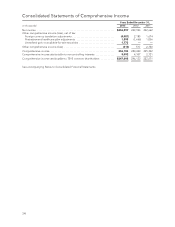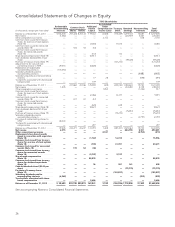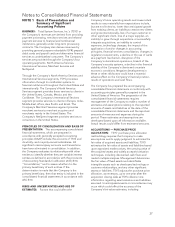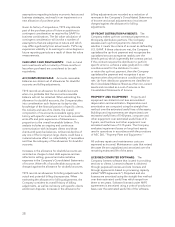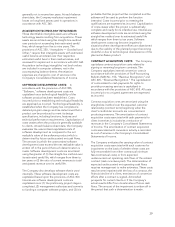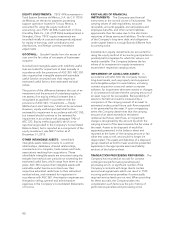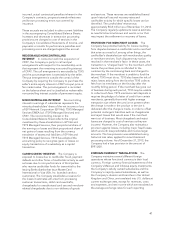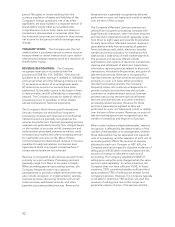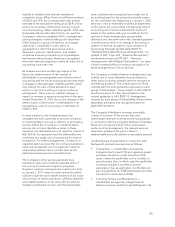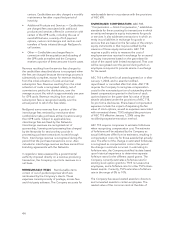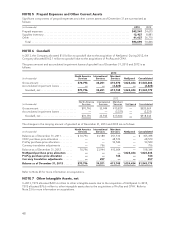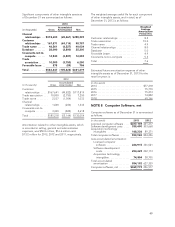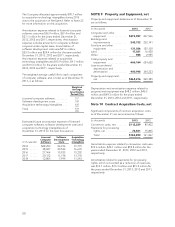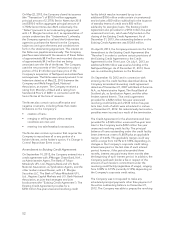NetSpend 2013 Annual Report Download - page 44
Download and view the complete annual report
Please find page 44 of the 2013 NetSpend annual report below. You can navigate through the pages in the report by either clicking on the pages listed below, or by using the keyword search tool below to find specific information within the annual report.period. Net gains or losses resulting from the
currency translation of assets and liabilities of the
Company’s foreign operations, net of tax when
applicable, are accumulated in a separate section of
shareholders’ equity titled accumulated other
comprehensive income (loss). Gains and losses on
transactions denominated in currencies other than
the functional currencies are included in determining
net income for the period in which exchange rates
change.
TREASURY STOCK: The Company uses the cost
method when it purchases its own common stock as
treasury shares or issues treasury stock upon option
exercises and displays treasury stock as a reduction of
shareholders’ equity.
REVENUE RECOGNITION: The Company
recognizes revenues in accordance with the
provisions of SAB No. 104. SAB No. 104 sets forth
guidance as to when revenue is realized or realizable
and earned when all of the following criteria are met:
(1) persuasive evidence of an arrangement exists;
(2) delivery has occurred or services have been
performed; (3) the seller’s price to the buyer is fixed
or determinable; and (4) collectability is reasonably
assured. The Company accrues for rights of refund,
processing errors or penalties, or other related
allowances based on historical experience.
The Company’s North America and International
Services revenues are derived from long-term
processing contracts with financial and nonfinancial
institutions and are generally recognized as the
services are performed. Payment processing services
revenues are generated primarily from charges based
on the number of accounts on file, transactions and
authorizations processed, statements mailed, cards
embossed and mailed and other processing services
for cardholder accounts on file. Most of these
contracts have prescribed annual revenue minimums,
penalties for early termination, and service level
agreements which may impact contractual fees if
certain service levels are not achieved.
Revenue is recognized as the services are performed,
primarily on a per unit basis. Processing contracts
generally range from three to ten years in length.
When providing payment processing services, the
Company frequently enters into customer
arrangements to provide multiple services that may
also include conversion or implementation services,
business process outsourcing services such as call
center services, web-based services, and other
payment processing-related services. Revenue for
these services is generally recognized as they are
performed on a per unit basis each month or ratably
over the term of the contract.
The Company’s Merchant Services revenues are
derived from long-term processing contracts with
large financial institutions, other merchant acquirers
and merchant organizations which generally range
from three to eight years and provide for penalties
for early termination. Merchant services revenue is
generated primarily from processing all payment
forms including credit, debit, electronic benefits
transfer and check truncation for merchants of all
sizes across a wide array of retail market segments.
The products and services offered include
authorization and capture of electronic transactions,
clearing and settlement of electronic transactions,
information reporting services related to electronic
transactions, merchant billing services, and point-of-
sale terminal services. Revenue is recognized for
merchant services as those services are performed,
primarily on a per unit basis. When providing
merchant processing services, the Company
frequently enters into customer arrangements to
provide multiple services that may also include
conversion or implementation services, business
process outsourcing services such as call center
services, terminal services, and other merchant
processing-related services. Revenue for these
services is generally recognized as they are
performed on a per unit basis each month or ratably
over the term of the contract. Revenues on point-of-
sale terminal equipment are recognized upon the
transfer of ownership and shipment of product.
When a sale involves multiple deliverables, revenue
recognition is affected by the determination of the
number of deliverables in an arrangement, whether
those deliverables may be separated into separate
units of accounting, and the valuation of each unit of
accounting which affects the amount of revenue
allocated to each unit. Pursuant to ASC 605, the
Company uses vendor-specific objective evidence of
selling price (VSOE) when it exists to determine the
amount of revenue to allocate to each unit of
accounting. The Company establishes VSOE of
selling price using the price charged when the same
service is sold separately. In certain situations, the
Company does not have sufficient VSOE. In these
situations, TSYS considered whether sufficient third
party evidence (TPE) of selling price existed for the
Company’s services. However, the Company typically
is not able to determine TPE and has not used this
measure of selling price due to the unique and
proprietary nature of some of its services and the
42




